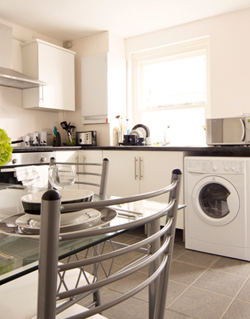Dulux Trade sheds light on the University of Salford's energy study
Paints from the Dulux Trade Light & Space colour range have been used in a ground-breaking study by The University of Salford into reducing domestic energy consumption. The company's innovative light-reflecting coatings were utilised as part of the project, a £10 million investigation into how to make the UK's pre-1920s housing stock more sustainable.

According to the university, the country's least energy efficient homes were constructed prior to the 1920s, yet around 4.5 million of these properties are still inhabited today and account for 23 per cent of the UK's total C02 emissions. With this in mind, The University of Salford and contractor, ISG, recreated a full-size, typical Victorian terrace house within a large concrete-lined space at the university's campus. During the study, which is being supported by the British Research Establishment (BRE), academics at the university will conduct tests inside the house to ascertain the impact of different variables on the building's energy consumption.
Just one of the variables being considered is the impact of certain colours, and how particular wallcoverings alter the perceived temperature and light within a room. To explore this, the architect for the project, Steve Baker of Halliday Meecham Architects, specified coatings from the Dulux Trade Light & Space portfolio for internal substrates within the home.
The first of its kind, Dulux Trade Light & Space is created through a unique combination of innovative optical brighteners, more reflective paint components and cleaner tinting recipes. In particular, the range uses and builds on patented light reflecting LumiTec™ technology which optimises the Light Reflectance Value (LRV) of each of the 26 colours in the collection.
In comparison to traditional paints, Dulux Trade Light & Space absorbs an average of 50 per cent less light than conventional emulsion paint, enhancing the illuminance and making rooms feel bigger, brighter and less gloomy.
As a result, an average of 22 per cent of lighting energy can be saved by allowing lower wattage energy efficient bulbs to be used to the same effect as standard ones. This means, lights can be switched on twenty minutes later every day on average - all of which equates to turning off one in every five 60W filament bulbs.
"15 per cent of homes in the UK were built prior to 1920, so it's essential that we explore specific ways to reduce the environmental impact of these buildings," said Steve Waterworth, The University of Salford's Energy House Project Manager. "To achieve this aim, we have to consider how every element can impact on the energy performance of the home. By using an innovative product such as Dulux Trade Light & Space we were able to analyse how something as simple as paint can make a difference to efficiency levels."
Andrew Trobe, Specification Account Manager at Dulux Trade, added: "Traditionally, the main role of decorative coatings has been to protect a surface or create a colour scheme. However, with new advances in technology, paint can now provide benefits beyond aesthetics, and the Dulux Trade Light & Space range is a perfect example of this."
